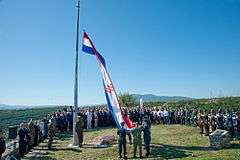Victory Day (Croatia)
Victory and Homeland Thanksgiving Day and the Day of Croatian Defenders (Croatian: Dan pobjede i domovinske zahvalnosti i Dan hrvatskih branitelja) is a public holiday in Croatia that is celebrated annually on 5 August, commemorating the Croatian War of Independence.[1] On that date in 1995 the Croatian Army took the city of Knin during Operation Storm, which effectively brought an end to Republic of Serbian Krajina proto-state.[2] In 2008, the Croatian Parliament also assigned the name Day of Croatian Defenders (Croatian: Dan hrvatskih branitelja) to the holiday, which honors the current service members and veterans of the Republic of Croatia Armed Forces.[3]
| Victory Day | |
|---|---|
 Soldiers raising the Flag of Croatia on Knin Fortress, 5 August 2011 | |
| Official name | Dan pobjede i domovinske zahvalnosti i Dan hrvatskih branitelja |
| Observed by | Croatia |
| Significance | Operation Storm |
| Date | 5 August |
| Next time | 5 August 2021 |
| Frequency | annual |

Celebrations
The main celebration is centered in Knin where there are festivities commemorating the event, beginning with a mass and laying of wreaths in honour of those who died in the war, and continuing with parades and concerts. The event is attended by thousands, including the country's leading politicians.[4] The Flag of Croatia on Knin Fortress is ceremonially raised as part of the celebrations.[5]
2015 Parade
A special military parade of the Armed Forces in honor of Victory Day was held on 4 August 2015 in Zagreb, celebrating the twentieth anniversary of Operation Storm.[6] The parade was opened by the Honor Guard Battalion on the lawns of the National and University Library, with three Mikoyan-Gurevich MiG-21's flying over the city.[7] Lijepa naša domovino was performed by 12-year old Mia Negovetić, accompanied by the Croatian Armed Forces Band and the Croatian Navy's vocal ensemble.[8] It aroused great public interest considering that the last military parade in Croatia was organized in 1997. About 100,000 spectators attended the parade, additional sound systems were installed at the last minute until the intersection of City of Vukovar and Savska Streets.[9] The editorial board of the Zagreb based Jutarnji list, gave a positive review of the parade, demanding the introduction of regular parades for Victory Day.[10] Military analyst Igor Tabak praised the event, while criticizing the in authenticity of certain "historical units".[11]
Silver Jubilee
On the silver jubilee in 2020, the celebrations were attended for the first time ever by an ethnic Serb political representative, Deputy Prime Minister Boris Milošević, a move which was applauded across the political spectrum, with Prime Minister Andrej Plenković among others stating that it will "send a new message for Croatian society".[12] On top of this, Plenković, as well as President Zoran Milanović sent messages of peace to the people of Serbia.[13][12] Opposition to the move from the Deputy Prime Minister came from members of the political far-right such as the Homeland Movement and the Croatian Defence Forces.
See also
- Public holidays in Croatia
- Operation Storm
- Victory Day in other countries
References
- Croatian Parliament (21 November 2002). "Zakon o blagdanima, spomendanima i neradnim danima u Republici Hrvatskoj" (in Croatian). Narodne novine. Retrieved 25 June 2011.
- "5. kolovoza - Dan pobjede i domovinske zahvalnosti i Dan hrvatskih branitelja". Hrvatski sabor (in Croatian). Retrieved 31 March 2020.
- "Sabor: 5. kolovoza ubuduće će se slaviti i kao Dan branitelja". Jutarnji list (in Croatian). 13 May 2008. Retrieved 25 June 2011.
- "Hrvatska slavi Dan pobjede i domovinske zahvalnosti" (in Croatian). Hrvatska radiotelevizija. 5 August 2002. Retrieved 27 December 2012.
- Katarina Zorić (5 August 2008). "Dan pobjede i domovinske zahvalnosti" [Victory and Homeland Thanksgiving Day]. Nacional. Archived from the original on 1 July 2012. Retrieved 1 July 2012.
- "Spektakularna vojna parada: Zadnji u koloni prošli tenkovi" (in Croatian). 24sata. 4 August 2015. Retrieved 5 August 2020.
- tportal.hr: MIG-ovi za kraj proparali nebo, predsjednica i premijer neobično ljubazni jedno prema drugome, tportal.hr, pristupljeno 4. kolovoza 2015.
- Dnevnik - Mia Negovetić pjeva himnu, retrieved 10 August 2020
- Krešimir Žabec, Rozita Vuković: "Foto: Hrvatska vojska i narod su jedno! Metropolom stupali vojnici, prolazili tenkovi, nebo parali MiG-ovi, građani im klicali", Jutarnji list, 4. kolovoza 2015.
- Gordanka Jureško: Komentar Jutarnjeg. Mimohod treba postati obveza za sve buduće generacije. Možda bi zakonom trebalo obvezati vlast da postane tradicija, Jutarnji list, objavljeno: 5. kolovoza 2015.
- Igor Tabak: "Što zapamtiti od mimohoda u Zagrebu?", obris.org, 18. kolovoza 2015.
- "Croatia marks 25 years since war with tolerance message". Al Jazeera. 5 August 2020. Retrieved 7 August 2020.
- Vladisavljević, Anja; Stojanović, Milica (5 August 2020). "Croatia Hails 25th Anniversary of Operation Storm Victory; Serbs Mourn". Balkan Insight. Retrieved 7 August 2020.